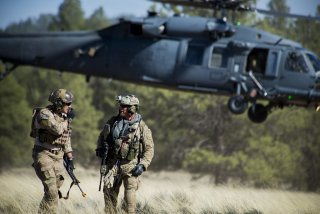Air Force Special Operators are Refocusing on the High-End Fight
The Air Force Special Operations Community is experiencing a pivot away from years of counterinsurgency back towards providing support to larger joint forces.
Here's What You Need to Know: While certain key missions such as medical evacuation or hostage rescue and recovery will likely still figure prominently when it comes to war preparations for Air Force Special Operations Forces, they may take on a new and different operational character. Air Force Special Operators have a lot of jobs. They can attack from V-22 Ospreys behind enemy lines, conduct high-risk aerial reconnaissance when confronted by advanced air defenses and fly dangerous fixed-wing close air support missions. In fact, all of these are all mission possibilities more likely to be taken up as the Special Operation ramp up preparations for major power warfare. “The AFSOC that we have is not the AFSOC we will need in the future,” Lt. Gen. James Slife, Commander, Air Force Special Operations Command, told The Mitchell Institute for Aerospace Studies in a recent video interview. In general terms, the Air Force Special Operations Community (AFSOC) is now experiencing a strategic pivot away from years of counterinsurgency back toward its earlier operational functions which primarily involved providing support to larger joint forces. “AFSOC had been a force that was largely geared to short term crisis response and contingency operations, and was generally used to serving a supporting role to the broader Joint Force. After September 11, both of those things changed. We needed to become something fundamentally different,” Slife said. Following the strategic, tactical and operational shift which emerged following 9/11, Air Force Special Operators were thrust into what Slife referred to as “the better part of 20 years without a break.” During Operation Enduring Freedom in Afghanistan, for example, the Air Force Special Tactics Squadron was used as forward-positioned targets identifying, laser painting or “lighting up” Taliban targets for attacking aircraft. This kind of counterinsurgency oriented air-ground targeting coordination, which proved vital in the early days of the war against the Taliban, aligns with the kinds of counterterrorism missions routinely conducted by Air Force Special Operators following 9/11. Small groups of dismounted special operators assigned to targeting missions, such as those relied upon during the wars in Iraq and Afghanistan, are not likely to be called upon in any kind of great power warfare, given that the small groups of individual airmen might be more vulnerable to a major power mechanized attack. While certain key missions such as medical evacuation or hostage rescue and recovery will likely still figure prominently when it comes to war preparations for Air Force Special Operations Forces, they may take on a new and different operational character. Rescue units will need to be fortified by substantial air support to ensure survivability as, in a great power warfare contingency, small groups of special operators are much more vulnerable to incoming enemy fire. The Light Attack Aircraft, for example, is a platform which could very well bring great utility to Air Force Special Operators looking to support advancing infantry closing with an enemy in a more traditional Combined Arms Maneuver formation. Yet, a platform and close-air support mission sphere such as this would also prove valuable in any kind of a counter-insurgency type scenario wherein small groups of disbanded enemy fighters were on the move in pickup trucks or fighting in more urban areas devoid of larger armored vehicles or large air attack systems. At the same time, a Light Attack Aircraft, much like the Special Operations AC-130 Gunship did provide supportive aerial fire in Afghanistan, could preserve a vital role in counterterrorism or counter-insurgency conditions as well, given that it could bring suppressive fire and attack down upon pockets of insurgents or terrorists. In either scenario, Air Force Special Operators conducting close air support missions would most likely reach optimal functionality should they operate in an area where the United States had air supremacy and could operate without major threats from advanced enemy air defenses. Kris Osborn is the defense editor for the National Interest. Osborn previously served at the Pentagon as a Highly Qualified Expert with the Office of the Assistant Secretary of the Army—Acquisition, Logistics & Technology. Osborn has also worked as an anchor and on-air military specialist at national TV networks. He has appeared as a guest military expert on Fox News, MSNBC, The Military Channel, and The History Channel. He also has a Masters Degree in Comparative Literature from Columbia University. This article first appeared in March 2021 and is being republished due to reader interest. Image: U.S. Air Force Flickr.

